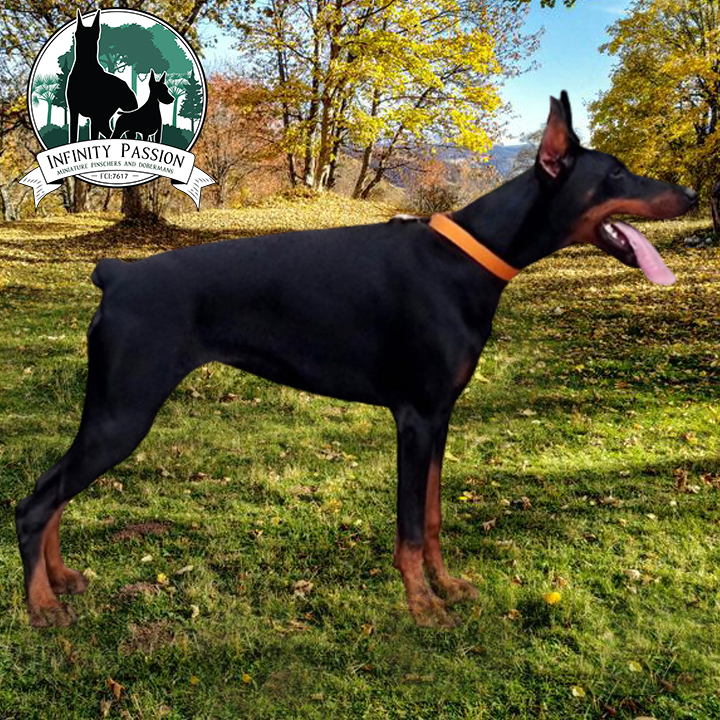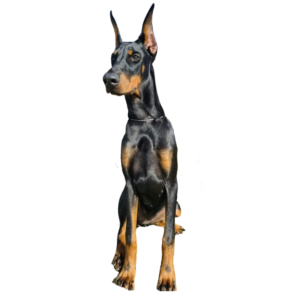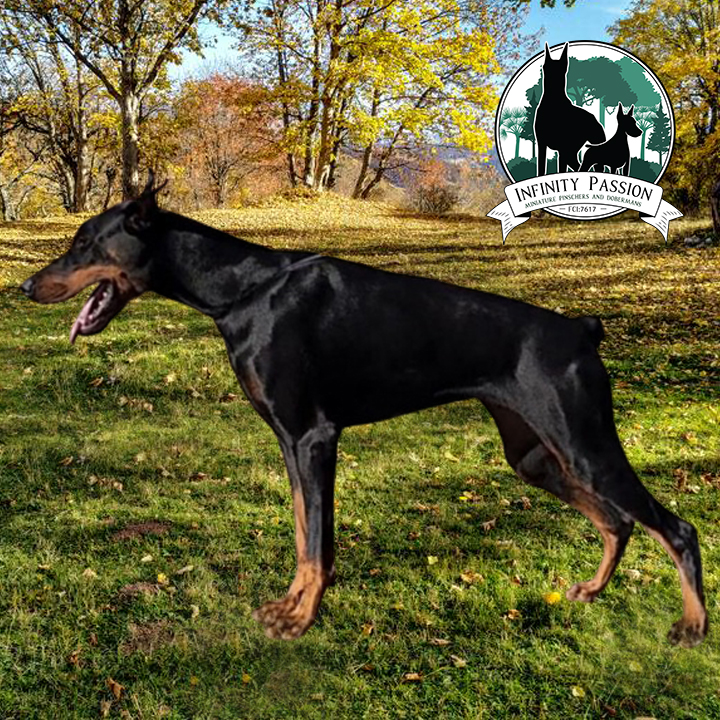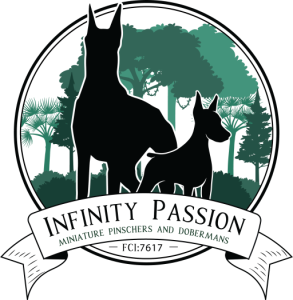Doberman is the only a breed named after its famous breeder, Friedrich Louis Doberman (January 2, 1834-June 9, 1894). According to tradition, he was a tax collector, street dog and city shinter, with the right to catch all stray dogs in the city. He used especially sharp dogs for breeding. A significant role in the creation of the Doberman was certainly played by "butcher's dogs", which, according to the concepts of the time, had the characteristic of a "breed". These dogs were a sort of forerunner of today's Rottweiler, mixed with a breed of shepherd that was bred in Thuringen, and was black with rust-red markings. With the listed mixes, the Doberman began breeding in the 70s of the last century.
He wanted to create his own breed, that is, a working dog that would also be a yard and pet dog.
Doberman breeding aims for a medium-sized, strong and muscular dog, which, in addition to mass, must have an elegant body.
General Appearance: The Doberman is medium-sized, strong and muscularly built. The elegance of the body, proud demeanor, temperament and expressiveness correspond to the image of an ideal dog.
Proportions: Doberman is a square dog, which especially applies to males. The length of the back should be equal to the height of the withers. In males, the length can exceed no more than 5%, in females no more than 10%, in relation to the height of the withers.
Temperament: Basically Doberman. is of a friendly nature, very attached to his family and a friend of children. It is desirable to have a medium pronounced temperament and medium sharpness, medium degree of irritability. With good leadership, the desire to work comes to the fore.

Head
Upper: Strong , corresponds to the structure of the body. Viewed from above, it corresponds to a blunt wedge. Seen from the front and from the side, the lines look straight, they don't break towards the ears. The rear arches are well developed, but not prominent in the front. The frontal furrow is visible. The occipital bone should not be prominent. Seen from the front and from above, the side lines of the head must not protrude. The slight lateral roundness of the upper jaw and cheekbones must be in harmony with the entire head. The musculature of the head is strongly developed and gathered together with the bones.
Stop: It is minimal, but recognizable (visible).
Private part
Nose: Nasal the mushroom is well built, more wide than round, with a large opening, without overall forward projection. In black dogs it is black, in brown it has a slightly lighter tone.
Jaw: The muzzle must be in good proportion to the skull and must be well developed. The jaw is deep, the mouth opening should be wide and reach the molars. Good width of the jaw must be expressed in the area of the upper and lower canines.
Lips: They should fit firmly and flat on the jaws, and form a clear connection with the mouth opening. . They are darkly pigmented, in brown dogs the tone is slightly lighter.
Teeth: Strong, both the upper and lower jaw are wide. The dentition is scissor-shaped, 42 teeth, normal size.
Eyes: Medium-sized, dark, oval. A slightly lighter tone is allowed for brown dogs. Eyelids fit well. The edge of the eyelid is hairless (eyelashes).
Ears: Set high, carried high, cropped so that their size is proportional to the length of the head. In countries where cropping is prohibited, uncropped ears are valued equally with cropped ears. It is desirable that they are of medium size and that their front edge rests on the cheeks.
Neck: Good length in relation to the head and body, dry and muscular. It rises from the chest and shoulders, is gracefully bent, carried upright and proudly held.
Body
Crest: Especially in the male should be expressed in height and length, and at the same time make the back line elevated in relation to the croup.
Back: They are short and firm. The back and loins are broad and muscular. The female can be a little longer in the loin part, as space is needed for the fruits.
Hocks: Extend from the sternum towards the root of the tail, with with a barely visible fall, but even so they are well rounded, neither flat nor suddenly falling (they are not steep). They are of good length and with good musculature.
Chest: The length and depth of the chest must be in proper proportion to the length of the back. At the same time, the depth, with slightly rounded ribs, is half the height of the crest. The chest has a good
width and the foreskin is particularly prominent in front (its base is the sternum with the associated musculature).
Belly line: From the end of the sternum to the pelvis, the belly is tucked in.
Tail: Set high and short, whereby two vertebrae should remain. Testicles: Males must have two normally developed and descended testicles. Front legs
Viewed from all sides, the front legs stand almost straight, i.e. vertical to the ground and are strongly developed.
Shoulder: Lies firmly against the chest, with well-developed muscles, on both sides of the withers. The shoulder blade goes up above the spinous processes of the thoracic spine. Preferably obliquely placed, and backwards at an angle of about 50 degrees.
Upper arm: Good length, well muscled, angle to the shoulder is 105-110 degrees.
Elbow: Well fitting, not pointed either in the field or inside.
Forearm: Strong and straight, well muscled. Length in a harmonious relationship to the body.
Hoofs: Strong.
Hoofs : Strong bones, straight when seen from the front, when viewed from the side - slanted at most 10 degrees.
Paws: Short and closed. Toes rounded up (cat's paw). The nails are short and black.
Hind legs: Viewed from behind, the Doberman has a pronounced broad and rounded musculature of the croup and pelvis. The supporting musculature from the pelvis to the upper leg and lower leg has good width at the upper leg, in the region of the knee and lower leg. Strong hind legs are straight and parallel.
Thighs: Good depth and width, with strong musculature. Good hip angle. The angle to the horizontal is 80-85 degrees.
Knee: Strong, it is made up of the upper leg, cup and lower leg. The knee angle is about 130 degrees.
Lower leg: Medium length in a harmonious relationship with the total length of the hind leg.
Hock: Medium strength, parallel. The tibia bones meet the tibia bones. The angle of the hock joint is about 140 degrees..
Hoof: Short and standing normally in relation to the ground.
Paws: As with the front ones, the toes are short, arched and closed. The nails are black and short.

Movement: Just as movement is important for utility value, it is also extremely important for exteriors. The step is elastic, lithe, free and conquering. The front legs go as far forward as possible. The rear legs are widely placed, elastically transmitting the power of thrust. The front leg of one side and the back leg of one side and the back leg of the other side move forward at the same time. Good firmness of back, legs and joints.
Skin: Fits well all over and is well pigmented.
Coat: Short, sharp and dense. It fits tightly, is flat and evenly distributed over the entire body. Undercoat is not allowed.
Color: Black or dark brown with rust red, sharply defined and clean tan. The burning is found on the jaws, as spots on the cheeks and eyebrows, on the throat, two spots on the chest, on the paws and
paws, on the inner sides of the thighs, around the anus and buttocks.
Size: The height of the withers of males is 68-72 cm, females 63-68 cm. Medium height is preferred. The mass of males is 40-45 kg, and females 32-35 kg.
Errors
General appearance: Not enough expressed characteristics of gender. Lack of substance light, heavy, high-legged, heavy-boned.
Head: Too strong, too narrow, too short, too long, too or too little pronounced stop, too strong
forehead furrow, weak lower jaw, round or almond-shaped eyes, bright eyes, too strong cheeks, loose lips, open or too deep eyes, ears set too high or too low, open corner of the lips (chews).
Neck: Slightly shorter, too short, excess skin on the throat, underarm, deer neck, too long (inharmonious). Body: Insufficiently firm back, drooping croup, sunken, saddle back, carp back, too little or too rounded ribs, insufficient depth of chest as well as too much width, too long back, lack of foreskin too high or too low set tail, insufficient or too gathered stomach.
Legs: Open or closed angles of the front or hind legs, loose elbows, the position of the bones and joints of the thigh deviates from the standard, narrow or wide toes. Cow-like, barrel-shaped, narrow stance of hind legs, open or soft paws, stunted toes, light nails.
Coat: Too light, somewhat limited, impure tan, too dark a mask, a large black spot on the legs, an almost invisible or oversized mark on the chest. Long, soft and shiny coat. Wavy hair, as well as areas with insufficient hair and areas without hair. Larger curls of hair, especially on the body, visible undercoat.

Temperament: Lack of security, too high temper, too sharp, aggressive, too low or too high irritability.
Size: Up to 2 cm deviation from the standard is acceptable. gait.
Disqualifying faults: Marked deviation from sexual characteristics.
Eyes : Yellow (raptors), differently colored eyes.
Dental: Prebiting, underbiting or pincer teeth and lack of teeth.
Testicles: Two undeveloped testicles in scrotum.
Hairiness:
White markings, pronounced long and wavy coat, pronounced light coat, larger hairless areas.
Temperament: Timid, nervous angry and excessively aggressive dogs.
Size: Deviation of more than 2 cm, up or down from the norm prescribed by the standard.

